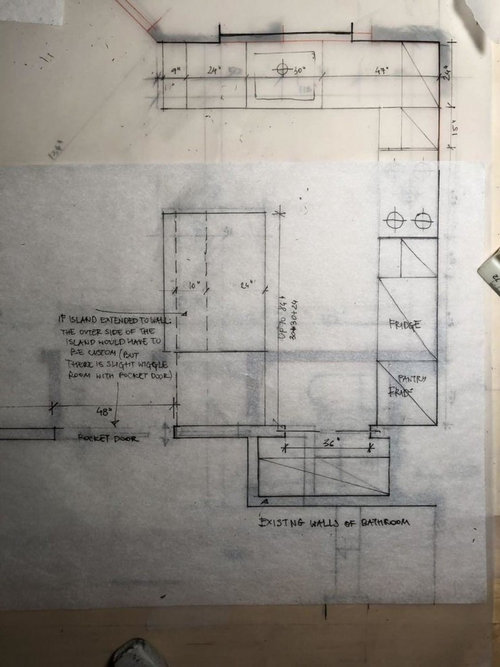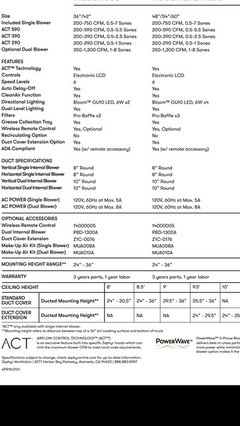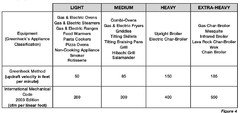90 degree turn in duct over range hood? or move the range?
Hello Houzzers,
Question - see below for the current design for our kitchen reno. The deck is behind the wall where the sink will be. Hence the range hood duct work will have to go up the wall and then make a 90 degree turn to go out to the deck. We are going to have a 36" Bluestar range and a 750Cfm zephyr range hood. Do you think the range hood efficacy will be lowered due to the 90 degree turn? Would you switch the range to the side where the sink is right now? It would cost more $$$ because our current kitchen has the same configuration as the sketch so no pipes etc would have to be moved. Advice please! thanks so much!

Comments (31)
wdccruise
5 years agoOn the Zephyr website, find your model and on the Specifications and Documents tab, open the "Hood User Manual". The Ducting Calculation Worksheet describes how to calculate the maximum allowable duct length considering any components (e.g., elbows, reducers) you include within the duct.
Dishington Construction - Jensen Hus
5 years agoAs long as you have the space to run the duct work then you're good. Don't change the design.
purpleproject
Original Author5 years agohi guys,
this is what the spec sheet says. we have 9 feet ceilings.
kaseki
5 years agoDumping the duct effluent onto the deck area does not seem to me to be a great idea, unless you can be fairly sure that the deck will not be occupied during any cooking session. Better is to go to another exterior wall, or up above the roofline. Even an exterior chase may be desirable to avoid mingling grease and odor with guests (unless you are only venting cilantro).
With an appropriate duct diameter, one 90-degree turn should should have much less effect on the blower pressure loss than (a) the baffles, and (b) the make-up air path restrictions.
purpleproject
Original Author5 years agohi kaseki,
if we sit out on the deck we are grilling outside and not cooking inside so it won't be a problem!kaseki
5 years agolast modified: 5 years agoThere are two types of external blowers, the residential style that blows down the roof or down the wall (Broan and Abbaka for example) and mini commercial up-blast blowers that throw the effluent away from the house. For least contamination of the wall and/or deck material, I would suggest the more obtrusive but cleaner up-blast units (operating in this case as horizontal-blast).
biondanonima (Zone 7a Hudson Valley)
5 years agoI would swap the range and sink, but not because of the vent necessarily - more because the workflow would be improved that way. If you don't mind having your sink so far from your fridge, though, you can certainly leave it as is.
purpleproject
Original Author5 years agohi Bion, this is the layout right now and I guess we are used to it because it works for us. :)M
5 years agoI don't think there is anything horribly wrong with your layout, and if you like it, then go for it. But don't stress too much about the cost of moving your plumbing. In our recent remodel, we made some rather drastic plumbing changes.
I asked our contractor, whether in hind-sight, we would have saved money if we hadn't reconfigured the layout as dramatically as we did. He said it made zero difference. Even for minor changes, we still would have had to call the plumber. And by the time everything is done, it really doesn't matter whether he moves the hook-up by 10" or by 10'.
Of course, that's only true because we had always planned on redoing the floors and walls anyway. Easy access makes plumbing and electrical work so much easier. If you have a less comprehensive project that doesn't open up the walls, then things might work out differently.
Also, I agree with other contributors and I would not vent towards the deck. It's easy to fix now, but there is a good chance you'll be annoyed later, if you don't heed this advice.dan1888
5 years agolast modified: 5 years agoYou can probably become used to a better layout with easier function. I'd also swap the sink and range. I'd investigate induction. Miele or Bosch.
purpleproject
Original Author5 years agothanks guys for all the great tips. let me run this by the KD (who hopefully doesn't want to kill me with all my waffling!!)cpartist
5 years agoIs this a gas Bluestar? If so i’m surprised how no one noted that you don’t have a sufficient sized hood. 750 com is fine for induction but not for gas
purpleproject
Original Author5 years agoyes Bluestar. it's the 36" stainless steel one (which has slightly lesser BTUs than the coloured ones) We really would very rarely if ever use all 6 burners at once. would the vent not suffice? it's what the appliance store guy recommendedcpartist
5 years agoAnd yes I would swap range and sink or put a prep sink on the island. As humans we learn to adapt even when things could function better
cpartist
5 years agoKawasaki has a formula on this site for figuring out how much btu you need. Try doing a search for it
purpleproject
Original Author5 years agoI would love to have the range the other side guys, where the sink is, but I have a window there and it would mean moving the window right?kaseki
5 years agocpartist wrote:
Kawasaki has a formula on this site for figuring out how much btu you need. Try doing a search for it
"Kawasaki" here. Aim for an actual 90 CFM per square foot of hood entry aperture, which should ideally overlap the cooktop. Blower rating needs to be higher in proportion to pressure loss in the baffles, ducting, MUA, etc. Use 1.5X in lieu of an analysis.Required hood flow rate depends on containment of the cooking plume which depends on its velocity which depends (mainly) on the pan contents temperature. Other fluid dynamics details can influence any given case.
kaseki = fossilKawasaki = city in Kanagawa.
purpleproject
Original Author5 years agothanks kaseki...still trying to understand what all this means but thanks for getting me started!
while I am here, can I ask about the heat shield behind range or more specifically how to install it so I can tile the backsplash behind the range? I have read all the threads about island trim etc but also see on Amazon they sell hear shields with spacers that can be tiled so I am very confused!kaseki
5 years agoThe AHJ will want to observe that you complied with your range's installation requirements given in the manufacturer's installation guide. UL and relevant codes will have influenced this guide's directions. Where the issue is combustible material, this seems to include most sheetrock, and wooden studs under sheetrock, as well as nearby cabinets. Non combustible sheetrock on steel studs is OK. But the shields are designed by the range manufacturer to avoid having the buyer reconstruct the kitchen wall so in most cases the shield should be used. Again, read the installation guide.
Specific to your question: Tile may not be combustible, but if it is on a combustible surface it does not eliminate the risk. I know nuttink about tiled spacers.
purpleproject
Original Author5 years agothanks kaseki et al. Appreciate it. As a follow up, I emailed Bluestar and their engineers said this. hope this helps others.
"
BlueStar ranges are intended to be installed with 0” clearance at the rear of the unit given con-
sideration to non-combustible surfaces.
An island trim can be installed either in an island or against a wall with zero clearance as long
as the following conditions are met. When the unit is installed in an island condition, the is-
land trim itself should be kept a minimum of 6” from combustible materials at the rear. When
the unit is installed in a zero clearance condition, non-combustible/heat resistant materials are
to be used in a vertical plane for a minimum distance of 6” below the top horizontal plane of the
unit and 6” above the top horizontal plane of the unit where the unit meets the back wall.
When a unit is installed with any other back guard in a zero clearance condition, non-
combustible/heat resistant materials are to be used in a vertical plane for a minimum distance of
6” below the top horizontal plane of the unit and at least equal in height to the back guard being
used.
The non-combustible material need not extend horizontally past the initial barriers
thickness. The initial barrier should consist of materials such as ceramic tile, cement backer
board, stainless steel (.032” Thick) or other non-combustible material. Non-combustible mate-
rials are defined as non-combustible as in the form in which the material is used and under the
conditions anticipated, the material will not aid combustion or add appreciable heat to an ambi-
ent fire or materials that are in compliance with ASTM E 136. Refer to the appropriate instal-
lation manual and/or local building code for additional information."Patricia Colwell Consulting
5 years agoEvery turn in ductwork increase the need for additional CFM and IMO 750CFM is already minimal for the range so relook at different vent hoods
purpleproject
Original Author5 years agoPatricia, we would never be using all 6 or even 4 burners at one time!kaseki
5 years agolast modified: 5 years agoAh! you missed one of the versions of a comment I have added to quite a few threads. Here it is again. Because we do not get to close off parts of the hood not receiving cooking plume impact, all of the hood has to flow the amount needed at the most stressing part of the effluent plume to be contained at the hood baffle space.
How much do we need? Well the actual issue is what velocity of air has to be pulled past the baffles to ensure that the rising plume is pulled into the baffles and contained, versus reflecting off of the baffles and potentially curling back into the room, thereby escaping the capture area and hence removal by the hood.
Hot cooking plumes over gas burners can rise at velocities of 1.2 m/s, or almost 4 ft/s. The baffle gap is roughly half the baffle assembly area, so to entrain the plume flow, it seems that some portion of 4 ft/s or 4 x 60 CFM per sq. ft. of baffle area is needed for good containment. Actually, there is usually space under the baffles larger than the baffles proper, so adequate flow is needed all across the hood capture aperture.
I believe that I have about 900 actual CFM at home, pulled through a 10 sq. ft. Wolf Pro Island hood. This is equivalent to 90 ft/s. This works over induction hobs, including searing and wok cooking with a 3500W Cooktek wok hob.
As it happens, Greenheck also looked into the requirements for CFM, perhaps like me doubting that 100 CFM per ft. of hood edge had a mathematical connection to the process of cooking plume containment. They have published a range of values, and I have taken the liberty of copying their relevant table below.
So take your hood area, multiply by some value you believe in for actual needed flow, then multiply by another factor to account for blower ratings not actually applying to the conditions in which they are used. (Another topic written about here more than a few times.)
http://www.greenheck.com/media/pdf/otherinfo/KVSApplDesign_catalog.pdf

No one has complained here that aiming for 90 CFM/sq. ft. of hood aperture allowed smoke and steam to escape into the kitchen, so long as the hood overlapped the cooking area by enough to capture the expanding plumes.purpleproject
Original Author5 years agothanks kaseki .I will forward this on to my mathematically inclined husband!robertgoulet
5 years agoso kaseki, 750cfm would be fine for her range no? 36" hood assuming 24" depth is 3x2=6...x90cfm= 540CFM? Or if they go to a 42" hood which would be better thats just 630CFM?

kaseki